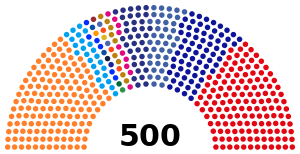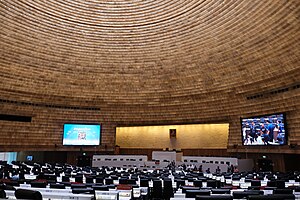House of Representatives (Thailand)
The factual accuracy of parts of this article (those related to parts which are written in past tense due to being written in the context of the 2007 Thai constitution) may be compromised due to out-of-date information. (September 2023) |
House of Representatives สภาผู้แทนราษฎร Sapha Phuthaen Ratsadon | |
|---|---|
National Assembly of Thailand | |
| Leadership | |
First Deputy Speaker | Padipat Suntiphada, Fair Party since 5 July 2023 |
Second Deputy Speaker | Pichet Chuamuangphan, Pheu Thai since 5 July 2023 |
Srettha Thavisin, Pheu Thai since 22 August 2023 | |
Government Chief Whip | Wisut Chaiyarun, Pheu Thai since 22 February 2024 |
Opposition Chief Whip | Pakornwut Udompipatskul, Move Forward since 26 December 2023 |
| Structure | |
| Seats | 500 |
 | |
Political groups | Government (315)
|
Length of term | Up to 4 years |
| Elections | |
| Parallel voting: First-past-the-post voting (400 seats) Party-list proportional representation (100 seats) | |
Last election | 14 May 2023 |
Next election | By 27 June 2027 |
| Meeting place | |
 | |
| Phra Suriyan Chamber Sappaya-Sapasathan Dusit District Bangkok, Thailand | |
| Website | |
| www.parliament.go.th | |
| Rules | |
| Parliament Rules | |
 |
|---|
|
|
|
|
The House of Representatives (
The House of Representatives was temporarily abolished as a result of the
Role
Bill consideration

The Cabinet, no less than 20 members of parliament, or 10,000 eligible voters through a petition may introduce a bill. However, if it is a money bill (a bill that has provisions concerning taxes, budgetary affairs or currency), it may be introduced only with the endorsement of the Prime Minister.
Where a bill's status as a money bill may be in question, a session between the speaker and all house committee chairs maybe convened to consider the status of the bill. The decision is made by a simple majority vote. If the vote is tied, the speaker must cast a tie-breaking vote.
When the process of consideration ends in the House and the bill is agreed to, the bill is sent to the senate for further deliberations; of which the process must be done within 60 days. The deadline for money bills is 30 days. If the senate is not able to deliberate within the time limit, the bill is considered to be agreed to by the senate.
If the bill is agreed to by the whole of the National Assembly, the prime minister must wait 5 days in order to give people the opportunity to challenge the bill's constitutionality. After which, the prime minister has 20 days to present the bill to the monarch for royal assent.
Any emergency act passed by the cabinet must be sent to the house for consideration without delay to be examined. If the house approves of the emergency act, it becomes an ordinary act. If not, the emergency act ceases to have effect after the decision has been published in the
Budget consideration
The 2017 Thai Constitution stipulates that the budget must be written in the form of an act, and in the introduction of a budget bill the government must show sources of income and estimates of further income, standards and measures of outcome and relevance to the 20 Year National Strategy and other national development plans. The budget must also adhere to guidelines outlined in the State Fiscal and Financial Disciplines Act.
The process of considering the budget is almost the same as considering a bill, although the deliberation deadline is extended to 105 days, and the senate is not able to amend the budget and must vote on it within 20 days.
Scrutiny of the government
Questioning a minister
A member of parliament may submit a question to a minister both in writing and orally. Questions to a minister may be asked without the question being submitted in advance. A minister may refuse to answer the question if the answer would risk national security or if they consider it not to be in the national interest.
Ministers assigning civil servants or other people to answer in their place is commonplace practice rather than the exception.
Motion of no confidence
No less than one fifth of all the members of parliament may introduce a motion to debate about a vote of no confidence in individual ministers or the entire cabinet. A simple majority is required for the motion to pass, and subsequently for the minister or the entire cabinet to cease.
Creation of committees
Committees may be set up by the house to carry out affairs or investigate matters, or to study matters and report to the house according to a set time frame. A minister may be held accountable to the committee, and it is within their duty to aid the committee in the course of an investigation or to find facts by ordering civil servants within their ministry for them to testify in the committee or to comply with information requests.
Considering prime ministerial candidates
In order for a candidate to stand, they must receive at least one tenth of the house's vote and must be named in the party list.
History
The
See more at:
- 1946 – The 1946 constitution established a fully elected House of Representatives.
- 1949 – On June 5, 1949, Orapin Chaiyakan became the first woman to be elected to hold a post in the National Assembly of Thailand (specifically, the House of Representatives).[2][3]
- 1952 – Establishment of the unicameralNational Assembly with 123 members.
- 1959 – The House was banned by Sarit Dhanarajata.
- 1968 – The House was re-established with 219 members.
- 1972 – The House was banned by Thanom Kittikachorn.
- 1974 – Establishment of the House of Representatives.
- 1976 – Establishment of a unicameral National Assembly with 360 royally-appointed members.
- 1978 – Return of an elected House with 301 members.
- 1991 – Establishment of a unicameral National Assembly with 292 appointed members.
- 1997 – Establishment of a 500-member House of Representatives, 400 directly elected with 100 elected through proportional representation.
- 2006 – Following the coup, an interim charter was signed establishing a 250-member National Legislative Assembly.
- 2007 – Return to 500-member House with 375 members elected through single constituency elections and 125 appointed through party-list proportional representation, established, by referendum under the 2007 Constitution of Thailand.
- 2014 – Abolished as a result of the 2014 Thai coup d'état.
- 2017 – Re-established following the promulgation of the 2017 constitution.
Qualification
The qualifications to be a
Those specifically barred from being candidates were those: addicted to drugs, declared
Elections
Before its abolition, the House of Representatives had 500 members. 375 members were directly elected in single constituency elections by first-past-the-post voting. The 375 constituencies were divided by population according to the census and tambons. The other 125 members were voted based on the Mixed Member Majoritarian system (MMM). In Thai general elections, voters had two votes: one to select the member of parliament for their constituencies and the second to choose which party they prefer. Seats were assigned to parties as a result through the d'Hondt method.
In accordance with the
Term and dissolution
The term of the House of Representatives was exactly four years from the previous
The King held the royal prerogative to dissolve the House before its expiration. When this happened a royal decree was issued where the election date was announced; this had to be done in no less than forty days and not more than sixty days from the date of the dissolution. The reasons and circumstances of a dissolution could be made only once.
Membership
Members of the House of Representatives were generally called Members of Parliament or MPs (
In the case where the vacancy was made by a proportional representative member, the vacancy would be filled by the Speaker of the House of Representatives by submitting the name of the next candidate in the
Leadership
Presiding officers
The executive committee of House of Representatives consisted of one
This section needs to be updated. (December 2023) |
Leader of the Governing Coalition
The Constitution stipulated that the Prime Minister and the Ministers had to be former members of the House of Representatives. After the first session, the House had to vote in a resolution to elect a Prime Minister, after which the King would formally approve him within thirty days. The Prime Minister-elect was always the leader of the largest party in the House. However, under the electoral system, the House resulted in a hung parliament. After the 2007 election, six parties formed a governing coalition, electing Samak Sundaravej of the largest party, People's Power Party (PPP), the Prime Minister.
On August 5, 2011, the House elected Yingluck Shinawatra as Prime Minister against Abhisit Vejjajiva of the Democrat Party, to a vote of 265 for and 159 against.
Leader of the Opposition
After the appointment of the Cabinet, the King appointed the official Leader of the Opposition of Thailand. The Leader of the Opposition had to be the leader of the largest party with no members holding any ministerial positions. His party had to be larger than one fifth of the total number of the House. If no Party met this qualification then the Leader with most votes from parties with no ministerial positions would then be appointed. The Royal appointment had to be countersigned by the President of the National Assembly. The Leader of the Opposition led the Shadow Cabinet of Thailand.
See also
- Constitutions of Thailand
- 2007 Constitution of Thailand
- National Assembly of Thailand
References
- Constitution of the Kingdom of Thailand 2007
- Background Note: Thailand: U.S. State Department public domain document
- ^ Kendall, Dave (2019-01-06). "Explainer: New rules for the House of Representatives". Bangkok Post. Retrieved 2019-01-28.
- ^ Sopchokchai, Orapin. Female Members of Parliament, Women's Political Participation at the National Level Archived 2011-07-24 at the Wayback Machine, Women's Political Participation in Thailand, TDRI Quarterly Review, Vol. 13, No. 4, December 1998, pp. 11–20
- ^ Iwanaga, Kazuki. Women in Politics in Thailand Archived 2012-03-17 at the Wayback Machine, Working Paper No. 14, Centre for East and South-East Asian Studies, Lund University, Sweden, 2005
